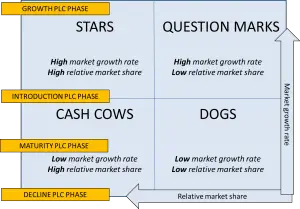 The concept of the product life cycle is fundamental to understanding how product portfolios will evolve over time through the quadrants of the BCG matrix.
The concept of the product life cycle is fundamental to understanding how product portfolios will evolve over time through the quadrants of the BCG matrix.
Conceptually, the product life cycle, suggests that most product portfolios will categories will progress through different stages of rates of growth – from introduction to growth to maturity and then to eventual decline.
Introduction is very early growth, while a mature market should also have a small level of growth, usually almost in line with increases in GDP.

This second diagram highlights the typical product life-cycle pattern – however, there are variations of this pattern for fads (short-term products), style and fashion products as well as products that are essentially reinvented for the consumer and then go from maturity into another period of growth.
However, for the purposes of understanding the BCG matrix, we will concentrate on the typical product life-cycle curve only.
As you can see, stars and question marks only occur in the introduction and growth stages. While cash cows and dogs exist during times of maturity and decline. Therefore, new product portfolios categories will start off as either a star or as a question mark and then in the longer term will progress downwards (to either a cash cow or a dog).
In today’s market, many new products and technology breakthroughs are being adopted by the market much faster than previously, which then indicates the period of time that a product portfolio will remain as a star or as a possible question mark is decreasing.
